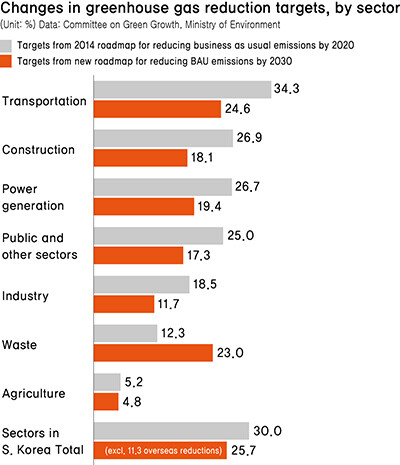hankyoreh
Links to other country sites 다른 나라 사이트 링크
Greenhouse gas reductions announced, a major step back from last year

South Korea confirmed quantities and percentages of greenhouse gases to be reduced in various sectors to honor its pledged reduction targets by 2030.
But the sector reduction targets were a major step back from initially planned levels - a development many saw coming when the government submitted an Intended Nationally Determined Contributions (INDC) plan to the UN last year that indicated it would achieve 11.3 percentage points of its 2030 reduction target of 37% of business-as-usual (BAU) emissions through overseas reductions.
At a Cabinet meeting on Dec. 6, the government decided on a “basic national roadmap for greenhouse gas reductions by 2030” allocating 219 million tons of necessary domestic greenhouse gas reductions among the 315 million tons to reduced by 2030 to eight areas, including power generation, industry, and construction, the Ministry of Environment reported.
The roadmap called for the biggest reduction of 64.5 million tons in the power generation sector, which is to be achieved through adoption of low-carbon power sources, management of electricity demand, and higher electricity transmission and supply efficiency. The industrial sector, which includes steel, petrochemicals, and 20 other business types, is to achieve 56.4 million tons of reductions through energy efficiency improvements, gas development through environmentally friendly processes, refrigerant replacement, innovative technologies, and waste resource use. Other absolute greenhouse gas reduction amounts assigned include 35.8 million tons for buildings, 28.2 million tons for new energy industries, 25.9 million tons for transportation, 3.6 million tons for public and other sectors, 3.6 million tons for waste, and one million tons for agriculture and livestock.
In terms of percentage reductions assigned compared to BAU values, the biggest cuts were in transportation at 24.6%, followed by waste at 23%, power generation at 19.4%, buildings at 18.1%, and public and other sectors at 17.3%. The lowest reduction percentage assignment was for agriculture and livestock at 4.8%, followed by industry at 11.7%.
Comparison of the values in the recent road map and those found in the 2014 “national road map for achieving greenhouse gas reduction targets” shows lower reduction rates for all seven sectors besides waste. The new road map’s transportation reduction rate of 24.6% was fully ten percentage points lower than the 34.3% assigned in the previous road map based on 2020 BAU levels; rates also fell from 26.9% to 18.1% for buildings and from 26.7% to 19.4% for power generation. Only in the case of waste did the rate increase, nearly doubling from 12.3% to 23%.
The government said it plans to develop a “detailed pursuit plan for overseas greenhouse reduction” by 2020 to achieve 96 million tons of reductions, or 11.3% of 2030 greenhouse gas BAU levels, through purchasing of emissions rights via the international market mechanism (IMM) proposed in the Paris Agreement.
Also decided at the Cabinet meeting on Dec. 6 was an initial framework plan for climate change response, which included South Korea’s medium- and long-term plans for climate change response beyond greenhouse gas reductions, including adaptation to climate change and international cooperation.
By Kim Jung-soo, senior staff writer
Please direct questions or comments to [english@hani.co.kr]

Editorial・opinion
![[Column] Park Geun-hye déjà vu in Yoon Suk-yeol [Column] Park Geun-hye déjà vu in Yoon Suk-yeol](https://flexible.img.hani.co.kr/flexible/normal/500/300/imgdb/original/2024/0424/651713945113788.jpg) [Column] Park Geun-hye déjà vu in Yoon Suk-yeol
[Column] Park Geun-hye déjà vu in Yoon Suk-yeol![[Editorial] New weight of N. Korea’s nuclear threats makes dialogue all the more urgent [Editorial] New weight of N. Korea’s nuclear threats makes dialogue all the more urgent](https://flexible.img.hani.co.kr/flexible/normal/500/300/imgdb/original/2024/0424/7317139454662664.jpg) [Editorial] New weight of N. Korea’s nuclear threats makes dialogue all the more urgent
[Editorial] New weight of N. Korea’s nuclear threats makes dialogue all the more urgent- [Guest essay] The real reason Korea’s new right wants to dub Rhee a founding father
- [Column] ‘Choson’: Is it time we start referring to N. Korea in its own terms?
- [Editorial] Japan’s rewriting of history with Korea has gone too far
- [Column] The president’s questionable capacity for dialogue
- [Column] Are chaebol firms just pizza pies for families to divvy up as they please?
- [Column] Has Korea, too, crossed the Rubicon on China?
- [Correspondent’s column] In Japan’s alliance with US, echoes of its past alliances with UK
- [Editorial] Does Yoon think the Korean public is wrong?
Most viewed articles
- 1‘We must say no’: Seoul defense chief on Korean, USFK involvement in hypothetical Taiwan crisis
- 2N. Korean delegation’s trip to Iran shows how Pyongyang is leveraging ties with Moscow
- 3Amnesty notes ‘erosion’ of freedom of expression in Korea in annual human rights report
- 4[Column] Park Geun-hye déjà vu in Yoon Suk-yeol
- 5‘Weddingflation’ breaks the bank for Korean couples-to-be
- 6[Reportage] On US campuses, student risk arrest as they call for divestment from Israel
- 7[Editorial] New weight of N. Korea’s nuclear threats makes dialogue all the more urgent
- 8Why Korea shouldn’t welcome Japan’s newly beefed up defense cooperation with US
- 9[Guest essay] The real reason Korea’s new right wants to dub Rhee a founding father
- 10Will NewJeans end up collateral damage in internal feud at K-pop juggernaut Hybe?